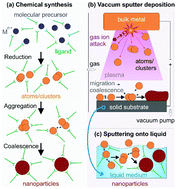Control of nanoparticles synthesized via vacuum sputter deposition onto liquids: a review
Abstract
Sputter deposition onto a low volatile liquid matrix is a recently developed green synthesis method for metal/metal oxide nanoparticles (NPs). In this review, we introduce the synthesis method and highlight its unique features emerging from the combination of the sputter deposition and the ability of the liquid matrix to regulate particle growth. Then, manipulating the synthesis parameters to control the particle size, composition, morphology, and crystal structure of NPs is presented. Subsequently, we evaluate the key experimental factors governing the particle characteristics and the formation of monometallic and alloy NPs to provide overall directions and insights into the preparation of NPs with desired properties. Following that, the current understanding of the growth and formation mechanism of sputtered particles in liquid media, in particular, ionic liquids and liquid polymers, during and after sputtering is emphasized. Finally, we discuss the challenges that remain and share our perspectives on the future prospects of the synthesis method and the obtained NPs.



 Please wait while we load your content...
Please wait while we load your content...